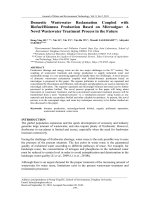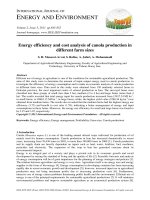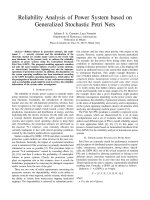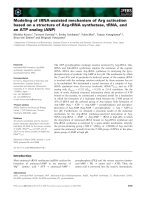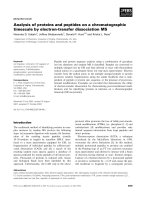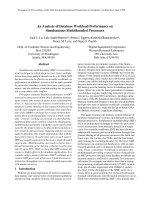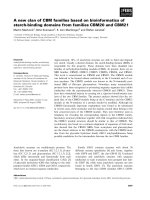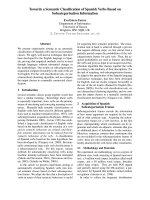Techno-Economic Analysis of Biofuels Production Based on Gasification docx
Bạn đang xem bản rút gọn của tài liệu. Xem và tải ngay bản đầy đủ của tài liệu tại đây (2.39 MB, 165 trang )
NREL is a national laboratory of the U.S. Department of Energy, Office of Energy
Efficiency & Renewable Energy, operated by the Alliance for Sustainable Energy, LLC.
Contract No. DE-AC36-08GO28308
Techno-Economic Analysis of
Biofuels Production Based on
Gasification
Ryan M. Swanson, Justinus A. Satrio, and
Robert C. Brown
Iowa State University
Alexandru Platon
ConocoPhillips Company
David D. Hsu
National Renewable Energy Laboratory
Technical Report
NREL/TP-6A20-46587
November 2010
NREL is a national laboratory of the U.S. Department of Energy, Office of Energy
Efficiency & Renewable Energy, operated by the Alliance for Sustainable Energy, LLC.
National Renewable Energy Laboratory
1617 Cole Boulevard
Golden, Colorado 80401
303-275-3000 • www.nrel.gov
Contract No. DE-AC36-08GO28308
Techno-Economic Analysis of
Biofuels Production Based on
Gasification
Ryan M. Swanson, Justinus A. Satrio, and
Robert C. Brown
Iowa State University
Alexandru Platon
ConocoPhillips Company
David D. Hsu
National Renewable Energy Laboratory
Prepared under Task No. BB07.7510
Technical Report
NREL/TP-6A20-46587
November 2010
NOTICE
This report was prepared as an account of work sponsored by an agency of the United States government.
Neither the United States government nor any agency thereof, nor any of their employees, makes any warranty,
express or implied, or assumes any legal liability or responsibility for the accuracy, completeness, or usefulness of
any information, apparatus, product, or process disclosed, or represents that its use would not infringe privately
owned rights. Reference herein to any specific commercial product, process, or service by trade name,
trademark, manufacturer, or otherwise does not necessarily constitute or imply its endorsement, recommendation,
or favoring by the United States government or any agency thereof. The views and opinions of authors
expressed herein do not necessarily state or reflect those of the United States government or any agency thereof.
Available electronically at />
Available for a processing fee to U.S. Department of Energy
and its contractors, in paper, from:
U.S. Department of Energy
Office of Scientific and Technical Information
P.O. Box 62
Oak Ridge, TN 37831-0062
phone: 865.576.8401
fax: 865.576.5728
email: mailto:
Available for sale to the public, in paper, from:
U.S. Department of Commerce
National Technical Information Service
5285 Port Royal Road
Springfield, VA 22161
phone: 800.553.6847
fax: 703.605.6900
email:
online ordering: />
Cover Photos: (left to right) PIX 16416, PIX 17423, PIX 16560, PIX 17613, PIX 17436, PIX 17721
Printed on paper containing at least 50% wastepaper, including 10% post consumer waste.
iii
Foreword
The purpose of this techno-economic analysis is to compare a set of biofuel conversion
technologies selected for their promise and near-term technical viability. Every effort is made to
make this comparison on an equivalent basis using common assumptions. The process design
and parameter value choices underlying this analysis are based on public domain literature only.
For these reasons, these results are not indicative of potential performance, but are meant to
represent the most likely performance given the current state of public knowledge.
iv
List of Acronyms
AGR acid gas removal
ASU air separation unit
BTL biomass to liquids
CFB circulating fluidized bed
DCFROR discounted cash flow rate of return
DME dimethyl-ether
FCI fixed capital investment
FT Fischer-Tropsch
GGE gallon of gasoline equivalent
HRSG heat recovery steam generator
HT high temperature
IC indirect costs
IGCC integrated gasification combined cycle
IRR internal rate of return
ISU Iowa State University
LHV lower heating value
LT low temperature
MEA monoethanolamine
MJ megajoule
MM million
MTG methanol to gasoline
MW megawatt
Nm
3
normal cubic meter
NREL National Renewable Energy Laboratory
PSA pressure swing adsorption
PV product value
Sasol South African Coal, Oil, and Gas Corporation
SPR slurry phase reactor
SMR steam methane reforming
SWGS sour water-gas-shift
TCI total capital investment
TDIC total direct and indirect cost
TIC total installed cost
tpd tons per day
TPEC total purchased equipment cost
WGS water-gas-shift
v
Executive Summary
This study compares capital and production costs of two biomass-to-liquid production plants
based on gasification. The goal is to produce liquid transportation fuels via Fischer-Tropsch
synthesis with electricity as a co-product. The biorefineries are fed by 2,000 metric tons per day
of corn stover. The first biorefinery scenario is an oxygen-fed, low-temperature (870°C), non-
slagging, fluidized bed gasifier. The second scenario is an oxygen-fed, high-temperature
(1,300°C), slagging, entrained flow gasifier. Both are followed by catalytic Fischer-Tropsch
synthesis and hydroprocessing to naphtha-range (gasoline blend stock) and distillate-range
(diesel blend stock) liquid fractions. (Hydroprocessing is a set of refinery processes that removes
impurities and breaks down large molecules to fractions suitable for use in commercial
formulations.)
Process modeling software (Aspen Plus) is utilized to organize the mass and energy streams and
cost estimation software is used to generate equipment costs. Economic analysis is performed to
estimate the capital investment and operating costs. A 20-year discounted cash flow rate of
return analysis is developed to estimate a fuel product value (PV) at a net present value of zero
with 10% internal rate of return. All costs are adjusted to the year 2007. The technology is
limited to commercial technology available for implementation in the next 5–8 years, and as a
result, the process design is restricted to available rather than projected data.
Results show that the total capital investment required for n
th
plant scenarios is $610 million and
$500 million for high-temperature and low-temperature scenarios, respectively. PV for the high-
temperature and low-temperature scenarios is estimated to be $4.30 and $4.80 per gallon of
gasoline equivalent (GGE), respectively, based on a feedstock cost of $75 per dry short ton. The
main reason for a difference in PV between the scenarios is because of a higher carbon efficiency
and subsequent higher fuel yield for the high-temperature scenario. Sensitivity analysis is also
performed on process and economic parameters. This analysis shows that total capital investment
and feedstock cost are among the most influential parameters affecting the PV, while least
influential parameters include per-pass Fischer-Tropsch-reaction-conversion extent, inlet
feedstock moisture, and catalyst cost.
In order to estimate the cost of a pioneer plant (first of its kind), an analysis is performed that
inflates total capital investment and deflates the plant output for the first several years of
operation. Base case results of this analysis estimate a pioneer plant investment to be $1.4 billion
and $1.1 billion for high-temperature and low-temperature scenarios, respectively. Resulting PVs
are estimated to be $7.60/GGE and $8.10/GGE for high-temperature and low-temperature
pioneer plants, respectively.
vi
Table of Contents
Introduction 1
Background 2
Biorenewable Resources 2
Gasification 2
Reactions 3
Gasifier Types 4
Biomass Preprocessing 7
Syngas Cleaning 9
End-Use Product 10
Power Generation 10
Synthetic Fuels and Chemicals 11
Methanol to Gasoline 11
Fischer-Tropsch 12
Techno-Economic Analysis 13
Methodology 16
Down-Selection Process 16
Preliminary Criteria 17
Scenario Selection 17
Scenarios Not Selected 18
Project Assumptions 18
Process Description 19
High-Temperature Scenario Overview 19
Low-Temperature Scenario Overview 20
Area 100 Preprocessing 22
Area 200 Gasification 23
Area 300 Syngas Cleaning 25
Area 400 Fuel Synthesis 27
Area 500 Hydroprocessing 29
Area 600 Power Generation 29
Area 700 Air Separation 30
Methodology for Economic Analysis 30
Methodology for Major Equipment Costs 34
Methodology for Sensitivity Analysis 35
Methodology for Pioneer Plant Analysis 36
Results and Discussion 39
Process Results 39
Cost Estimating Results 41
Capital and Operating Costs for n
th
Plant 41
Sensitivity Results for n
th
Plant 43
Pioneer Plant Analysis Results 45
Comparison with Previous Techno-Economic Studies 46
Summary of n
th
Plant Scenarios 48
Conclusions 49
References 50
vii
Appendix A. Techno-Economic Model Assumptions 55
Appendix B. Detailed Costs 59
Cost Summaries 59
Detailed Equipment Lists 61
Discounted Cash Flow 67
Appendix C. Scenario Modeling Details 71
Property Method 71
Stream/Block Nomenclature 71
Aspen Plus Calculator Block Descriptions 73
Aspen Plus Model Design Specifications 84
Detailed Calculations 86
Appendix D. Process Flow Diagrams 116
High-Temperature Scenario 117
Low-Temperature Scenario 127
Appendix E. Stream Data 138
High-Temperature Scenario 139
Low-Temperature Scenario 146
viii
List of Figures
Figure 1. Overall process flow diagram for both scenarios 1
Figure 2. Typical energy content of the products of gasification of wood using air varied by
equivalence ratio [12] 4
Figure 3. Design of fixed-bed (a) updraft and (b) downdraft gasifiers showing reaction zones[13]
5
Figure 4. Fluidized bed gasifier designs of (a) and (b) directly heated type and (c) and (d)
indirectly heated type [16] 6
Figure 5. Entrained-flow gasifier [18] 7
Figure 6. Schematic of a biomass pretreatment via fast pyrolysis followed by an entrained-flow
gasifier [17] 8
Figure 7. Main syngas conversion pathways [32] 11
Figure 8. Fischer-Tropsch reactor types (a) multi-tubular fixed bed and (b) slurry bed [31] 13
Figure 9. Overall process flow diagram for HT scenario 20
Figure 10. Overall process flow diagram for LT scenario 22
Figure 11. Fischer-Tropsch product distribution as a function of chain growth factor () using
equation 11 [48] 29
Figure 12. Sensitivity results for HT n
th
plant scenario 44
Figure 13. Sensitivity results for LT n
th
plant scenario 44
Figure 14. The effect of plant size on product value (per gallon of gasoline equivalent) for n
th
plant scenarios 45
Figure 15. The effect of plant size on total capital investment for n
th
plant scenarios 45
Figure B-1. Economic analysis summary for HT scenario 59
Figure B-2. Economic analysis summary for LT scenario 60
Figure C-1. Stream nomenclature used in model 71
Figure C-2. Block nomenclature used in model 71
Figure C-3. Heat and work stream nomenclature used in model 72
Figure C-4. Decision diagram for carbon balance 80
Figure C-5. Decision diagram for hydrogen balance 81
Figure C-6. Decision diagram for oxygen balance 82
Figure D-1. Overall plant area process flow diagram for HT scenario 117
Figure D-2. Preprocessing area process flow diagram for HT scenario 118
Figure D-3. Gasification area process flow diagram for HT scenario 119
Figure D-4. Syngas cleaning area process flow diagram for HT scenario 120
Figure D-5. Acid gas removal area process flow diagram for HT scenario 121
Figure D-6. Sulfur recovery area process flow diagram for HT scenario 122
Figure D-7. Fuel synthesis area process flow diagram for HT scenario 123
Figure D-8. Hydroprocessing area process flow diagram for HT scenario 124
Figure D-9. Power generation area process flow diagram for HT scenario 125
Figure D-10. Air separation unit process flow diagram for HT scenario 126
Figure D-11. Overall plant area process flow diagram for LT scenario 127
Figure D-12. Preprocessing area process flow diagram for LT scenario 128
Figure D-13. Gasification area process flow diagram for LT scenario 129
Figure D-14. Syngas cleaning area process flow diagram for LT scenario 130
Figure D-15. Acid gas removal area process flow diagram for LT scenario 131
ix
Figure D-16. Sulfur recovery process flow diagram for LT scenario 132
Figure D-17. Fuel synthesis area process flow diagram for LT scenario 133
Figure D-18. Syngas conditioning area process flow diagram for LT scenario 134
Figure D-19. Hydroprocessing area process diagram for LT scenario 135
Figure D-20. Power generation area process flow diagram for LT scenario 136
Figure D-21. Air separation unit process flow diagram for LT scenario 137
List of Tables
Table 1. Reactions Occurring within the Reduction Stage of Gasification 3
Table 2. Previous Techno-Economic Studies of Biomass-Gasification Biofuel Production
Plants 15
Table 3. Process Configurations Considered in Down Selection Process 16
Table 4. Main Assumptions Used in n
th
Plant Scenarios 18
Table 5. Stover and Char Elemental Composition (wt %) 23
Table 6. Syngas Composition (Mole Basis) Leaving Gasifier for Gasification Scenarios
Evaluated 25
Table 7. Fischer-Tropsch Gas Cleanliness Requirements [31] 27
Table 8. Hydroprocessing Product Distribution [49] 29
Table 9. Main Economic Assumptions for n
th
Plant Scenarios 30
Table 10. Methodology for Capital Cost Estimation for n
th
Plant Scenarios 32
Table 11. Variable Operating Cost Parameters Adjusted to $2007 33
Table 12. Sensitivity Parameters for n
th
Plant Scenarios 35
Table 13. Pioneer Plant Analysis Parameters and Factors 38
Table 14. Power Generation and Usage 39
Table 15. Overall Energy Balance on LHV Basis 40
Table 16. Overall Carbon Balance 41
Table 17. Capital Investment Breakdown for n
th
Plant Scenarios 42
Table 18. Annual Operating Cost Breakdown for n
th
Plant Scenarios 43
Table 19. Catalyst Replacement Costs for Both Scenarios (3-Year Replacement Period) 43
Table 20. Pioneer Plant Analysis Results 46
Table 21. Comparison of n
th
Plant LT Scenario to Tijmensen et al. Study IGT-R Scenario 47
Table 22. Comparison of n
th
Plant LT Scenario to Larson et al. Study FT-OT-VENT Scenario . 48
Table 23. Main Scenario n
th
Plant Results 48
Table B-1. Detailed Equipment List for Areas 100 and 200 of HT Scenario 61
Table B-2. Detailed Equipment List for Areas 300, 400, and 500 of HT Scenario 62
Table B-3. Detailed Equipment List for Areas 600 and 700 of HT Scenario 63
Table B-4. Detailed Equipment List for Areas 100 and 200 of LT Scenario 64
Table B-5. Detailed Equipment List for Areas 300, 400, and 500 of LT Scenario 65
Table B-6. Detailed Equipment List for Areas 600 and 700 of LT Scenario 66
Table B-7. Discounted Cash Flow Sheet for Construction Period and Years 1-8 of HT
Scenario 67
Table B-8. Discounted Cash Flow Sheet for Years 9-20 of HT Scenario 68
Table B-9. Discounted Cash Flow Sheet for Construction Period and Years 1-8 of LT Scenario69
Table B-10. Discounted Cash Flow Sheet for Years 9-20 of LT Scenario 70
Table C-1. Detailed Description of Stream and Block Nomenclature 72
x
Table C-2. Reaction Extent Equations for Each Alkane Hydrocarbon 75
Table C-3. Combustion Reactions to Determine Required Oxygen 77
Table C-4. Hydroprocessing Product Blend 84
Table E-1. Overall Plant Stream Data for HT Scenario 139
Table E-2. Preprocessing Area Stream Data for HT Scenario 140
Table E-3. Gasification Area Stream Data for HT Scenario 141
Table E-4. Syngas Cleaning Area Stream Data for HT Scenario 142
Table E-5. Acid Gas Removal and Sulfur Recovery Areas Stream Data for HT Scenario 143
Table E-6. Fuel Synthesis Area Stream Data for HT Scenario 144
Table E-7. Hydroprocessing, Power Generation, and Air Separation Areas Stream Data for
HT Scenario 145
Table E-8. Overall Plant Stream Data for LT Scenario 146
Table E-9. Preprocessing Area Stream Data for LT Scenario 147
Table E-10. Gasification Area Stream Data for LT Scenario 148
Table E-11. Syngas Cleaning Area Stream Data for LT Scenario 149
Table E-12. Acid Gas Removal and Sulfur Recovery Areas Stream Data for LT Scenario 150
Table E-13. Fuel Synthesis Area Stream Data for LT Scenario 151
Table E-14. Syngas Conditioning Area Stream Data for LT Scenario 152
Table E-15. Hydroprocessing, Power Generation, and Air Separation Areas Stream Data for
LT Scenario 153
1
Introduction
This study investigates the economic feasibility of the thermochemical pathway of gasification of
biomass to renewable transportation fuels. The objective is to compare capital investment costs
and production costs for n
th
plant biorefinery scenarios based on gasification. The selected
scenarios are high-temperature (slagging) gasification and low-temperature (dry-ash)
gasification, each followed by Fischer-Tropsch synthesis and hydroprocessing. They are
designed to produce liquid hydrocarbon fuels from 2,000 dry metric tons (2,205 dry short tons)
per day of agricultural residue, namely corn stover. Corn stover is chosen as a feedstock in order
to facilitate comparisons with biochemical and pyrolysis biofuels scenarios [1, 2].
The two scenarios were chosen from many options according to the following criteria:
1. The technology under consideration should be commercially ready in the next 5–8 years.
2. The size of the biorefinery should be feasible with current agricultural productivity and
within a realistic feedstock collection area.
3. In addition, the desired end product should be compatible with the present fuel
infrastructure, i.e., gasoline and/or diesel.
The high-temperature gasification scenario is based on a steam/oxygen-fed entrained flow,
slagging gasifier similar to that described in Frey and Akunuri [3]. The low-temperature
gasification scenario is based on a pressurized, steam/oxygen-fed fluidized bed gasifier
developed by the Gas Technology Institute and reported by Bain [4]. The main areas of operation
are feedstock preprocessing, gasification, syngas cleaning, syngas conditioning/upgrading, fuel
synthesis, power generation, and air separation (for oxygen production), as shown in Figure 1.
Process modeling software is utilized to organize the mass and energy streams, and cost
estimation software is used to generate equipment costs. Economic analysis is performed to
estimate the capital investment and operating costs. A 20-year discounted cash flow rate of
return (DCFROR) analysis is developed to estimate a fuel product value (PV) at a net present
value of zero with 10% internal rate of return. All costs are adjusted to the year 2007.
Figure 1. Overall process flow diagram for both scenarios
2
Background
Biorenewable Resources
The world population has long utilized materials that were in close proximity. The nearest
resource available to the human population is the organic matter in the environment around it.
This organic matter is present for a limited amount of time due to its decomposable nature.
Brown [5] defines this material, or biorenewable resources, as organic material of recent
biological origin. It is a renewable resource if the rate of consumption is equal to the
regeneration or growth and therefore must be used only if preserving biodiversity [6]. As a
result, these resources have been important contributors to the world economy, providing
foodstuffs, transportation, energy, and construction materials, as well as serving many other
functions.
Biorenewable resources for generating energy can be classified as woody biomass, energy crops,
residues, and municipal waste [6]. The first two are primary resources while the remaining are
secondary resources, meaning that their primary use has already occurred. Woody biomass
includes logging products and energy crops include short-rotation trees such as poplar and fast-
growing grasses such as switchgrass. Residues can come from logging processing or agricultural
processing (e.g., corn stover). According to Perlack et al. [7], the energy crop and agricultural
residue potential in the United States is 1.4 billion annual tons. According to the U.S.
Department of Energy’s “Roadmap for Agriculture Biomass Feedstock Supply in the U.S.,”
there is potential for 2 billion annual tons, including municipal waste and biosolids such as
manure.
Many end products can be produced from these resources. Aside from the conventional use of
biomass for human food consumption, livestock feed, and building materials, there are many
new pathways to provide renewable alternatives to our transportation, infrastructure, and energy.
Combustion of biomass offers a way to provide heat and power and displaces coal and fuel oil.
Fermentation of carbohydrates and liquefaction of biomass through fast pyrolysis yield liquid
products with the potential to displace petrochemicals. Gasification of biomass allows for
chemical and liquid fuel synthesis, which is the focus of this study.
Developing an economy that involves biorenewable resources, especially biofuels, has many
benefits. According to Greene et al. [8], biofuel production has the potential to provide a new
source of revenue for farmers by generating $5 billion per year. Additionally, toxic and
greenhouse gas emissions can be reduced by the use of biofuels. In the same study, Greene et al.
report that 22% of the United States’s total greenhouse gas emissions could be reduced if
biofuels were developed to replace half of the petroleum consumption. Arguably, the most
important benefit of biofuel production is the potential for closing the carbon cycle.
Gasification
Gasification is a high-temperature and catalytic pathway for producing biofuels. It is defined as
the partial oxidation of solid, carbonaceous material with air, steam, or oxygen into a flammable
gas mixture called producer gas or synthesis gas [5]. The synthesis gas contains mostly carbon
monoxide and hydrogen with various amounts of carbon dioxide, water vapor, and methane.
Typical volumetric energy content of synthesis gas is 4–18 MJ/Nm
3
[9]. Comparatively, natural
gas (composed of mostly methane) energy content is 36 MJ/Nm
3
[9]. Much of the energy content
3
of the biomass is retained in the gas mixture by partial oxidation rather than full oxidation of the
biomass, which would result in the release of mostly thermal energy. Historically, gasification of
coal and wood produced “town gas,” which was subsequently burned in street lamps [10].
Additionally, during the World Wars, vehicles were adapted to operate with gasification reactors
[10]. During this same time period, Germany developed the catalytic synthesis of transportation
fuels from synthesis gas [11]. The same concept is still in use today by the South African Coal,
Oil, and Gas Corporation (Sasol) to produce motor fuels and liquid by-products using coal [11].
Reactions
Four stages occur during gasification of carbonaceous material: drying, devolatilization,
combustion, and reduction [9]. First, the moisture within the material is heated and removed
through a drying process. Second, continued heating devolatilizes the material where volatile
matter exits the particle and comes into contact with the oxygen. Third, combustion occurs,
where carbon dioxide and carbon monoxide are formed from carbon and oxygen. The
combustion stage is very exothermic and provides enough heat for the last stage, the reduction
reactions, to occur. The last stage includes water gas reaction, Boudouard reaction, water-gas-
shift reaction, and methanation reaction (Table 1). As all these stages progress, solid fixed
carbon remains present. The amount of fixed carbon varies depending on the equivalence ratio.
Table 1. Reactions Occurring within the Reduction Stage of Gasification
Name Reaction
Water Gas
Boudouard
2
Water-Gas-Shift
Methanation
3
When the equivalence ratio (defined as the actual air/fuel ratio all divided by the stoichiometric
air/fuel ratio) increases, solid fixed carbon (i.e., char) decreases until enough oxidizer is available
for complete conversion (Figure 2). This point of complete conversion occurs at an equivalence
ratio of approximately 0.25. At nearly the same point, the maximum synthesis gas energy content
(without accounting for sensible energy) is reached.
4
Figure 2. Typical energy content of the products of gasification of wood using air varied by
equivalence ratio [12]
Gasifier Types
Three types of reactors are used for gasification: fixed bed, fluidized bed, and entrained flow
[13]. Fixed beds are fed with biomass from the top of the reactor and form a bed, which gasifies
as air moves through the bed (Figure 3). As the material releases volatile components, the char
and ash exit through a grate at the bottom. Typical operating temperature range is 750°–900°C.
The two main types of fixed-bed gasifiers are updraft and downdraft. The advantage of fixed-bed
technology is its simplicity, but the technology is limited in scale-up and has low heat mixing
due to high channeling potential within the reactor [14].
0
5
10
15
20
25
0 0.1 0.2 0.3 0.4 0.5 0.6 0.7 0.8 0.9 1
Enthalpy (MJ/kg biomass, moisture&ash-free)
Equivalence ratio (mol/mol)
total
g
as
,
total
g
as
,
sensible heat
g
as
,
heatin
g
value
char
,
total
char, sensible heat
char,
heating
value
5
(a) (b)
Figure 3. Design of fixed-bed (a) updraft and (b) downdraft gasifiers showing reaction zones [13]
When the volumetric gas flow is increased through the grate, the fixed bed becomes a fluidized
bed. Fluidized-bed gasifiers are so named because of the inert bed material that is fluidized by
oxidizing gas creating turbulence through the bed material (Figure 4). Biomass enters just above
the top of the bed and mixes with hot, inert material, creating very high heat and mass transfer.
Operating temperature range is the same as for the fixed bed. Advantages of the fluidized bed
include flexible feeds, uniform temperature distribution across the bed, and large volumetric flow
capability [15]. The main types of fluidized-bed gasifiers are circulating fluidized bed (CFB) and
bubbling fluidized bed. Bubbling-bed gasifiers are directly heated from the combustion reactions
occurring in the bed. They produce gas and the ash and char fall out the bottom or the side. The
CFB recycles the char through a cyclone while the product leaves out the top of the cyclone.
There are also indirectly heated fluidized beds that use a hot material such as sand to provide the
heat needed for gasification, as shown in Figure 4. Fluidized beds have high carbon conversion
efficiencies and can scale up easily [14].
6
(a) Bubbling fluidized-bed gasifier (b) Circulating fluidized-bed gasifier
(c) Indirectly heated gasifier via
combustor
(d) Indirectly heated gasifier via heat
exchange tubes
Figure 4. Fluidized bed gasifier designs of (a) and (b) directly heated type and (c) and (d) indirectly
heated type [16]
Another type of gasifier is the entrained-flow gasifier (Figure 5). Normally operated at elevated
pressures (up to 50 bar), it requires very fine fuel particles gasified at high temperatures to ensure
complete gasification during the short residence times in the reactor. The Energy Research
Centre of the Netherlands has investigated this type of gasification and reported promise with
biomass, as long as the biomass is pretreated to certain requirements [17]. To keep the residence
time at approximately the time for a particle to fall the length of the reaction zone, fuel particles
smaller than 1 mm and high temperatures (1100°–1500°C) are necessary for successful
operation.
7
Figure 5. Entrained-flow gasifier [18]
Entrained-flow gasification mixes the fuel with a steam/oxygen stream to form a turbulent flow
within the gasifier. Ash-forming components melt in the gasifier and form a liquid slag on the
inside wall of the gasifier, effectively protecting the wall itself. The liquid flows down and is
collected at the bottom. To form the slag, limestone can be added as a fluxing material. For
herbaceous biomass, such as switchgrass or corn stover, which is high in alkali content, there
may be sufficient inherent fluxing material present [18]. Advantages of entrained-flow
gasification are that tar and methane content are negligible and high carbon conversion occurs
due to more complete gasification of the char. Syngas cleanup is simplified because slag is
removed at the bottom of the gasifier, negating the need for cyclones and tar removal [19]. The
disadvantages are that very high temperatures need to be maintained and the design and
operation is more complex. An entrained-flow gasifier co-firing up to 25% biomass with coal has
been developed by Shell in Buggenum, Netherlands. Another gasifier developed by Future
Energy in Freiburg, Germany, uses waste oil and sludges. Both are operating at commercial scale
[17].
Biomass Preprocessing
A degree of biomass processing is required before gasification can occur. Most gasifiers require
smaller size feedstock than is typically collected during harvest. Therefore, a significant degree
of size reduction is necessary. A typical setup for size reduction is using a two-step process in
which a chipper accomplishes the primary reduction and a hammer mill is used for the secondary
reduction [20]. In addition, the maximum moisture content for biomass gasification is 20%–30%
8
(wet basis), and for normal operation it is less than 15% (wet basis) [9]. Therefore, a drying
process is required to prepare the feedstock for gasification.
The main benefit of drying biomass is to avoid using energy within the gasifier to heat and dry
the feedstock [21]. Drier biomass also makes for more stable temperature control within the
gasifier. Rotary dryers typically operate utilizing hot flue gas from a downstream process as the
drying medium. They have high capacity but require long residence times. In addition, rotary
dryers have a high fire hazard when using flue gas [21]. To avoid using flue gas, rotary dryers
can use superheated steam, essentially an inert gas, when a combined-cycle heat and power
system is used downstream. That system has significant steam available for use because of the
steam produced in the steam cycle. An advantage of using steam for drying is better heat transfer
and therefore shorter residence time.
Pretreatment options for entrained-flow gasification include torrefaction followed by grinding to
0.1-mm particles, grinding to 1-mm particles, pyrolysis to produce bio-oil/char slurry (bioslurry),
and initial fluidized-bed gasification of larger particles coupled to an entrained-flow gasifier.
Torrefaction, essentially an oxygen-free roasting process, causes the biomass particles to be
brittle, which makes for easy grinding but releases up to 15% of the energy in the biomass via
volatile compounds [17]. The fluidized/entrained coupled option is attractive because of an
overall energy efficiency of 80%–85%, but it is expensive because two gasifiers are used in
series.
The bioslurry option is illustrated in Figure 6. Basically, a flash-pyrolysis process yields bio-oil
and char and is followed by a slagging, entrained-flow gasifier. Because this process utilizes an
entrained-flow gasifier, the feed must be pressurized. Fortunately, the pyrolysis slurry, already in
an emulsified liquid state, can be pressurized easily. Technology for slurry feeding is state of the
art as a result of experience with coal slurries [17]. The bioslurry still contains 90% of the energy
contained in the original biomass [22]. Another advantage is that no inert gas is needed for solids
pressurization, avoiding dilution of the feed, which would dilute the syngas. In the search for
cost-effective methods for production of syngas, this option has potential, but it isn’t as
developed as other technologies such as fluidized-bed gasification. The biggest challenge is
constructing and operating a large-scale pyrolysis process, because large-scale systems have not
been demonstrated [17].
Figure 6. Schematic of a biomass pretreatment via fast pyrolysis followed by an entrained-flow
gasifier [17]
9
Syngas Cleaning
Because the raw syngas leaving the gasifier contains particulates, tars, alkali compounds, sulfur
compounds, nitrogen compounds, and other contaminants, those components must be removed
or reduced significantly. Particulates and tars have the potential for clogging downstream
processes. Sulfur and nitrogen have the potential to poison downstream processes, especially
catalysts used in fuel synthesis applications. Moreover, another motivation for cleaning syngas is
meeting environmental emissions limits.
The syngas must be cooled before conventional gas cleanup is utilized. This can be
accomplished in two ways: direct quench by injection of water and indirect quench via a heat
exchanger. Direct quench is less expensive but dilutes the syngas. Direct quenching can also be
used to clean up the gas by removing alkali species, particulates, and tars [23].
Particulates are defined as inorganic mineral material, ash, and unconverted biomass or char
[24]. In addition, bed material from the gasifier is included in the particulates. Switchgrass
feedstock typically has 10% inorganic material in the form of minerals. Many gasifiers operate
with a 98%–99% carbon conversion efficiency where 1%–2% of the solid carbon is in the form
of char [24].
Particulates are primarily removed by physical systems such as cyclones, in which the heavy
particles fall down the center while the gases rise up and out of the cyclone. The initial step for
particulate removal is usually a cyclone. Importantly, particulates should be removed before the
gas is cooled down for cold gas cleaning. If removed after gas cooling, tars can condense onto
the particulates and potentially plug equipment. Alternatively, barrier filters, which operate
above tar condensation temperatures, use metal or ceramic screens or filters to remove
particulates while allowing the gas to remain hot. Barrier filters, however, have presented
problems in sintering and breaking [24].
Even more critical to downstream syngas applications is tar removal. Tars are defined as higher-
weight organics and oxygenated aromatics heavier than benzene (78 g/mol). They are produced
from volatized material after polymerization [24]. A review by Milne et al. [25] of tars produced
during gasification covers different removal methods. One method uses physical removal via wet
gas scrubbing of tars in a scrubbing tower for the “heavy tars” followed by a venturi scrubber for
lighter tars. This setup is similar to the direct quench cooling mentioned previously, as cooling
occurs as well. Tar concentration is reported to be lower than 10 ppm by volume at the exit of
this setup [23]. The disadvantage of this setup is that wastewater treatment is required to dispose
of the tar and can be expensive.
The other method for tar removal is catalytic or thermal conversion to non-condensable gas. This
is also known as hot gas cleaning, as it occurs at temperatures at or above gasification
temperatures. Catalytic conversion can occur at temperatures as low as 800°C, and thermal
conversion can occur at temperatures up to 1200°C. The energy required for thermal tar cracking
may not be cost-competitive because of the temperature rise required from the gasification
temperature to crack the high refractory tars [24].
10
Alkali compounds such as calcium oxide and potassium oxide are present in biomass. When
gasified, both either vaporize or concentrate in the ash. Condensation of these compounds begins
at 650°C, and they can deposit on cool surfaces causing equipment clogging, equipment
corrosion, and catalyst deactivation [26]. According to Stevens [26], research on alkali
adsorption filters using bauxite has been promising but not demonstrated on a large scale.
Stevens concludes that the best current method for alkali removal is using proven syngas cooling
followed by wet scrubbing, where the addition of water cools the syngas and physically removes
small particles and liquid droplets.
Wet scrubbing also removes ammonia that forms during gasification from the nitrogen in the
biomass. Without proper removal, ammonia can deactivate catalysts as well. Complete ammonia
removal can be accomplished through wet scrubbing [27]. For gasifiers coupled to a catalytic or
thermal tar reformer, most of the ammonia can be reformed to hydrogen and nitrogen [27].
Sulfur in the biomass mostly forms hydrogen sulfide (H
2
S) with small amounts of carbonyl
sulfide (COS). Hydrogen sulfide is removed by three main ways: chemical solvents, physical
solvents, and catalytic sorbents. For chemical removal, amine-based solvents are typically
utilized to chemically bond with H
2
S. Physical removal takes advantage of the high solubility of
H
2
S using an organic solvent. Typical setups of both chemical and physical removal involve an
absorber unit followed by a solvent regenerator unit, known as a stripper. Operation usually
occurs at temperatures lower than 100°C and medium to high pressures (150–500 psi) [27].
Sulfur leaving these two systems is around 1–4 ppm and can require further removal, especially
for fuel synthesis. In that case, a syngas polishing step using a fixed-bed zinc oxide-activated
carbon catalyst removes H
2
S and COS to achieve the parts per billion levels necessary for fuel
synthesis. Halides, present in trace amounts in the biomass, can also be removed with the zinc
oxide catalyst [27]. The water streams with the scrubbed-out impurities are sent to wastewater
treatment.
End-Use Product
After syngas is cleaned of particulates, impurities, and contaminants, there is sufficient energy
content for producing a higher valued product. There are three main large-scale biomass
gasification pathways that have been researched and suggested for producing higher valued
products: power generation, liquid-fuel synthesis, and chemical synthesis. According to Wender
[28], the three largest commercial uses for syngas are ammonia production from hydrogen,
methanol synthesis, and hydrocarbon synthesis via the Fischer-Tropsch process.
Power Generation
Power is most effectively generated using gasification by combusting the syngas in a gas turbine
to provide mechanical work for a generator. Steam can then be generated by recovering heat
from the hot syngas, and the steam in turn is used for mechanical work via a steam turbine. This
gasifier plus gas turbine and steam turbine setup is known as integrated gasification combined
cycle (IGCC) power generation. The level of particulates, alkali metals, and tar can decrease the
performance of the gas turbine. Consonni and Larson [29] found that particulates can cause
turbine blade erosion; 99% of 10-micron or smaller particles should be removed. In addition,
they also report that alkali metals corrode the turbine blades and tars condense on the turbine
blades, both hindering operation and escalating turbine failure. Fortunately, nearly all alkali
metals and tars can be removed using proven wet scrubbing techniques.
11
Using the IGCC approach to generate power, Bridgwater et al. [30] and Craig and Mann [23]
expect biomass to produce power with efficiencies in the range of 35%–40% with large scale
systems (greater than 100 MW net output) at the high end of the range. Moreover, Craig and
Mann suggest that future advanced turbine systems could reach 50% biomass-to-power
efficiency.
Synthetic Fuels and Chemicals
Instead of converting the energy content of the syngas to power, the energy content can be
condensed into a liquid energy carrier, or fuel. The conversion of syngas to fuels can only occur
in the presence of proper catalysts [31]. The catalytic reactions basically build up the small
molecules in the syngas (i.e., carbon monoxide and hydrogen) into larger compounds that are
more easily stored and transported. A summary of many catalytic pathways to fuels and
chemicals is shown in Figure 7. In most catalytic synthesis reactions, syngas cleanliness
requirements are very high. Most impurities and contaminants are removed to low parts-per-
million and even parts-per-billion concentrations. This means that significant cost must be
directed toward syngas cleaning.
Figure 7. Main syngas conversion pathways [32]
Methanol to Gasoline
Methanol is one of the top chemicals produced in the world [32]. Most commercially produced
methanol is synthesized via steam methane reforming and autothermal reforming. The synthesis
of methanol from syngas is highly exothermic (equation 1). The reaction occurs over a
12
Cu/ZnO/Al
2
O
3
catalyst at temperatures of 220°–275°C and pressures of 50–100 bar with a
catalyst lifetime of 2–5 years [31]. Wender [28] reports syngas-to-methanol conversion
efficiency can reach 99% with recycle, but per-pass efficiency is only about 25%.
2
(eqn. 1)
Although methanol can be used directly as a liquid fuel, it can also be converted into the
conventional transportation fuel range. This process is known as the methanol-to-gasoline
(MTG) process and was developed by the Mobil Oil Corporation [31]. In that process, methanol
is heated to 300°C and dehydrated over alumina catalyst at 27 atm, yielding methanol, dimethyl
ether (DME), and water. The exiting mixture reacts with a zeolite catalyst at 350°C and 20 atm
to produce 56% water and 44% hydrocarbons by weight. Of the hydrocarbon product, 85% is in
the gasoline range, with 40% of the gasoline-range product being aromatic. However, limitations
on the aromatic content of gasoline have been proposed in legislation [31]. The thermal
efficiency of the MTG process is 70% [11]. The overall MTG process usually includes multiple
MTG reactors in parallel to perform periodic catalyst regeneration by burning off coke deposits
[11]. Mobil operated a commercial plant producing 14,500 barrels per day in New Zealand
during the 1980s [32]. Alternatively, the reaction process could be stopped directly after the
methanol synthesis to focus on producing DME, because DME can be used as a diesel fuel
because it has a high cetane number. DME is formed from the dehydration reaction of methanol
over an acid catalyst γ-alumina. Per-pass efficiency can be as high as 50%. Overall, syngas-to-
DME production efficiency is higher than that for syngas to methanol [31]. However, DME is in
gaseous form at atmospheric conditions and needs to be pressurized for use in diesel engines
[33]. Therefore, engine modification is required; this is the main disadvantage for DME use as
transportation fuel.
Fischer-Tropsch
Fischer-Tropsch (FT) catalytic synthesis is a highly exothermic reaction producing a wide
variety of alkanes (equation 2).
2.1
(eqn. 2)
For gasoline-range products, higher temperatures (300°–350°C) and iron catalysts are typically
used. For diesel-range and wax products, lower temperatures (200°–240°C) and cobalt catalysts
are typically used [34]. Operating pressures are in the range of 10–40 bar. Product distribution
can be estimated using the Anderson-Schulz-Flory chain-growth-probability model, in which
longer hydrocarbon chains form as the temperature decreases. At high temperatures, selectivity
favors methane and light gases. This is a disadvantage if liquid fuel production is the focus. At
low temperatures, selectivity favors long-carbon-chain wax products requiring further
hydrocracking to the diesel range in a separate unit, which adds more construction cost but is
necessary for liquid fuel production.
Because of the highly exothermic reaction, the heat must be removed or the catalyst can be
deactivated. Two main types of reactors have been designed: a fixed-bed tubular reactor and a
13
slurry-phase reactor (Figure 8). Heat removal is crucial to the process and has been the focus of
reactor design development [31]. The fixed-bed reactor has many catalyst tubes with heat
removal achieved by steam generation on the outside of the tubes [35]. The fixed-bed reactor is
simple to operate and is well suited for wax production due to simple liquid/wax removal.
However, it is more expensive to build because of the many tubes and has a high pressure drop
across the reactor [36]. The slurry-phase reactor (SPR) operates by suspending catalyst in a
liquid and bubbling the syngas through from the bottom. Disadvantages of the SPR are more
complex operation and difficult wax removal. However, SPRs cost approximately 40% less to
build than fixed-bed reactors [36].
FT diesel is very low in sulfur, low in aromatic content, and has a high cetane number, making it
very attractive as a conventional fuel alternative. Emissions across the board decrease when
using FT diesel. A South Africa-based company, Sasol, has been producing transportation fuel
since 1955 using the FT process and supplies 41% of South Africa’s transportation fuel
requirements [31].
(a) (b)
Figure 8. Fischer-Tropsch reactor types (a) multi-tubular fixed bed and (b) slurry bed [31]
Techno-Economic Analysis
For biofuels technologies to be utilized in commercial applications, the economic feasibility
must be determined. A feasibility analysis is also called a techno-economic analysis, in which the
technical aspects of a project are coupled to the economic aspects. First, the basic theoretical
configuration is developed and a mass and energy balance is performed. Second, cost estimation
14
allows the investment and production cost of a biorefinery to be determined. With rising interest
in biorenewable resources, many techno-economic studies have been performed on power
generation and biofuel scenarios. These studies assist in understanding how the physical process
relates to the cost of producing renewable alternatives. Accuracy of results from these studies is
usually ±30% of the actual cost [5].
Previous studies of gasification-based biomass-to-liquid production plants estimate the cost of
transportation fuels to range from $12/GJ to $16/GJ ($1.60–$2.00 per gallon of gasoline
equivalent) [16, 37-40]. The same studies estimate total capital investment in the range of $191
million for 2,000 dry metric ton per day (tpd) input [39] to $541 million for 4,500 dry metric tpd
input [38].
A 1,650 dry metric tpd biomass-to-methanol plant based on gasification, with a production cost
of $15/GJ ($0.90/gal of methanol), is reported by Williams et al. [16] in 1991$ for $45/dry
metric ton of biomass. Williams et al. also shows the production cost of methanol-derived natural
gas to be $10/GJ ($0.60/gal of methanol). However, that study concludes that if a carbon tax
system was developed for lifecycle carbon emissions, then renewable methanol could become
competitive with natural-gas-derived methanol at a tax of approximately $90 per metric ton of
carbon. A more recent study by Larson et al. of switchgrass-to-hydrocarbons production in 2009
reports a production cost of $15.3/GJ ($1.90/gal of gasoline) in 2003$ for a 4,540 dry metric tpd
(5,000 dry short tpd) plant based on gasification [38].
Table 2 compares four biofuel production studies based on gasification. A range of cost year,
plant size, and feedstock cost show the diversity of characteristics and assumptions that techno-
economic studies use. In addition, resulting capital investment costs of the studies have a large
range. For example, the capital investment costs of the Phillips et al. [39] and Tijmensen et al.
[40] studies are $191 million and $387 million, respectively, at similar plant sizes. Reasons for
such a significant difference are choice of technologies and level of technology development.
The Phillips et al. study is a target study, meaning that it assumes future technology
improvement and therefore lower costs. Direct comparison is difficult because of the varying
assumptions used by each study.
